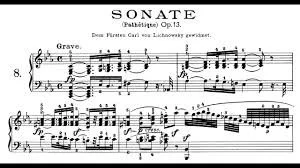Classical Music I Adored As A Teenager 4—Beethoven's Pathetique Piano Sonata
Music I Adored As A Teenager
FOURTH PIECE
Sonata in C minor (“Pathétique”), op. 13 by Ludwig van Beethoven
It’s lunchtime, 7th grade. In our orchestra room, once again, students surround the piano to hear someone playing Beethoven’s Pathétique sonata. We all love hearing that dramatic C minor chord. The tragic dissonances that follow. Then the quiet tender pleading chords denied with savage chords of fate. And that’s only the introduction! Then, like an eagle swooping down on its prey, a C minor scale whooshes down to the main theme.
Even during Beethoven’s own time, the Pathétique was all the rage. Piano students demanded to learn it, even as their teachers scoffed at it being too vulgar or modern. What did I love about it? That it was dramatic, fierce, brilliant, and super expressive. Along with the Moonlight Sonata, the Pathétique experimented with dramatic sonic possibilities for the piano that set young Beethoven apart from his contemporaries.
As I listen now, I realize Beethoven even inspired himself. I hear echoes of the Pathetique in his Appassionata sonata op. 57, and even in his very last sonata, op. 111, which is also in C minor. And listen carefully to the sublime Adagio in his 9th symphony— the beautiful opening theme is a variation of the Pathétique’s slow movement theme!
Check out the moments below that I found especially addictive in 7th grade…
1st movement
That main theme over the rumbling octave tremolos! It climbs in such defiance with chords that “stumble” from C minor to C major. The scale itself is a hybrid of C minor and F minor. Unpredictable and exciting. When the theme descends, it ends with a cadence that has a jazzy bass progression (A flat-F sharp-G). For theory folks, that is an augmented 6th progression.
The ascending primary theme, Beethoven Pathétique Mvt. 1
The second theme makes the piano sound like an orchestra. In the center are repeated chords that sound like string accompaniment while the theme above sounds like an oboe with echoes in the bass that are like bassoon.
The second theme, Beethoven Pathétique Mvt. 1
The closing section is fun to play. The main theme is now in contrary motion—scale going up while another goes down. And in between, is another tremolo accompaniment. So it has the sound of the main theme with the orchestration of the second theme!
Closing theme and codetta, Beethoven Pathétique Mvt. 1
The development section sustains the drama by cutting up both themes in small pieces that alternate with each other:
Both themes chopped up, development section, Beethoven Pathétique Mvt. 1
And don’t forget the weird dissonant rumble in the retransition (the music that prepares the recapitulation)
Bass rumble in the retransition, Beethoven Pathétique Mvt. 1
2nd movement
The melody that opens the slow movement is one of Beethoven’s most heartfelt, romantic themes.
Lyrical opening theme, Beethoven Pathétique Mvt. 2
Listen to the sliding chromatic inner voice that creates dissonance in the bridge that connects back to the lyrical theme. It’s very similar to the bass rumble in the first movement. I love how Beethoven picks up a small detail and continues to develop it throughout the sonata.
Dissonant bridge back to the lyrical theme, Beethoven Pathétique Mvt. 2
Like the second theme from mvt. 1, The middle section has a contrasting minor theme that recalls the same texture as the second theme from mvt. 1. Chords in the middle (upper strings playing triplets) sandwiched between a soprano “woodwind” melody on the top and the bass. It too sounds “orchestral,” with a woodwind playing the melody on top answered by a bassoon or lower strings in the bass.
Contrasting section in minor, Beethoven Pathétique Mvt. 2
How much richer the opening lyrical theme sounds when it returns, now with the more active accompaniment from the contrasting section!
Mvt. 3 Rondo (a rondo alternates a main theme or section with contrasting themes and sections—as in A B A C A B A)
I loved when I discovered that the Rondo theme is kind of a sped-up version of the beautiful slow movement melody. You can hear it clearly when its second phrase has the same falling fifths as the second phrase in the slow movement!
And then the middle of the rondo makes this connection between the movements even clearer. Those falling fifths (or rising fourths) are all in counterpoint.
The central C theme same shape as slow mvt. theme, Beethoven Pathétique Mvt. 3
I loved how the end of the Pathétique sonata brings back the dramatic C minor chords from the first movement. The sonata even finishes with the same downward “Eagle swoop” that began the Allegro in the first movement.
Exciting ending of Beethoven Pathetique Sonata
I was in awe of Beethoven’s imagination to connect all the movements as one idea. Incidentally, Pathétiquemeans passionate or tragically passionate. The title wasn’t Beethoven’s. His publisher added it. Same with the “Moonlight” sonata title. Clearly, the name Pathetique stuck. It captures its sense of defiance and resilience in the face of tragedy.
